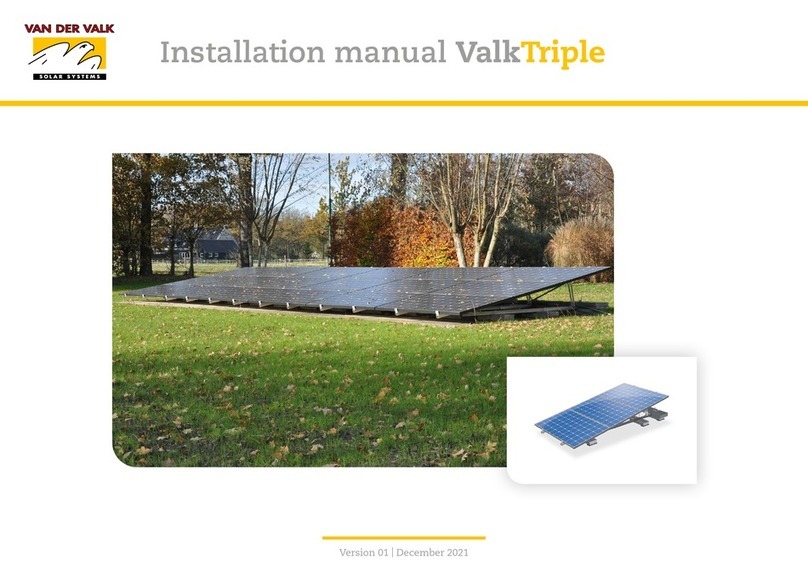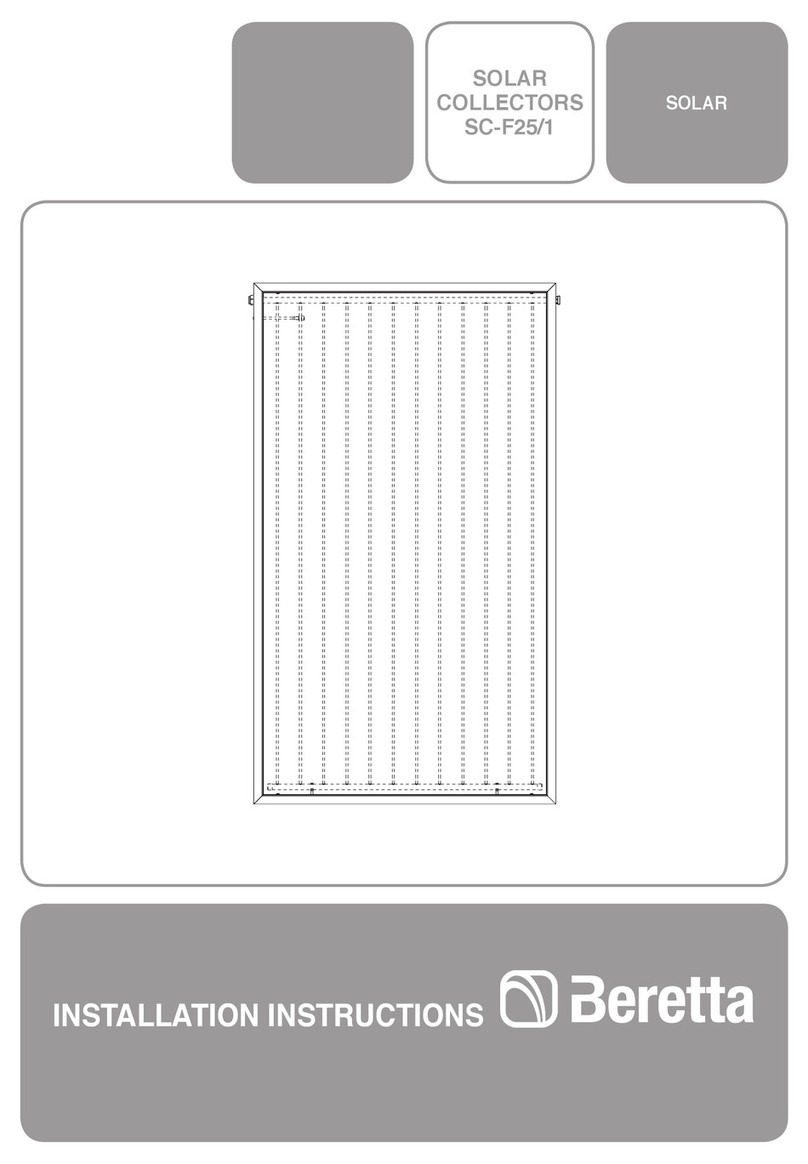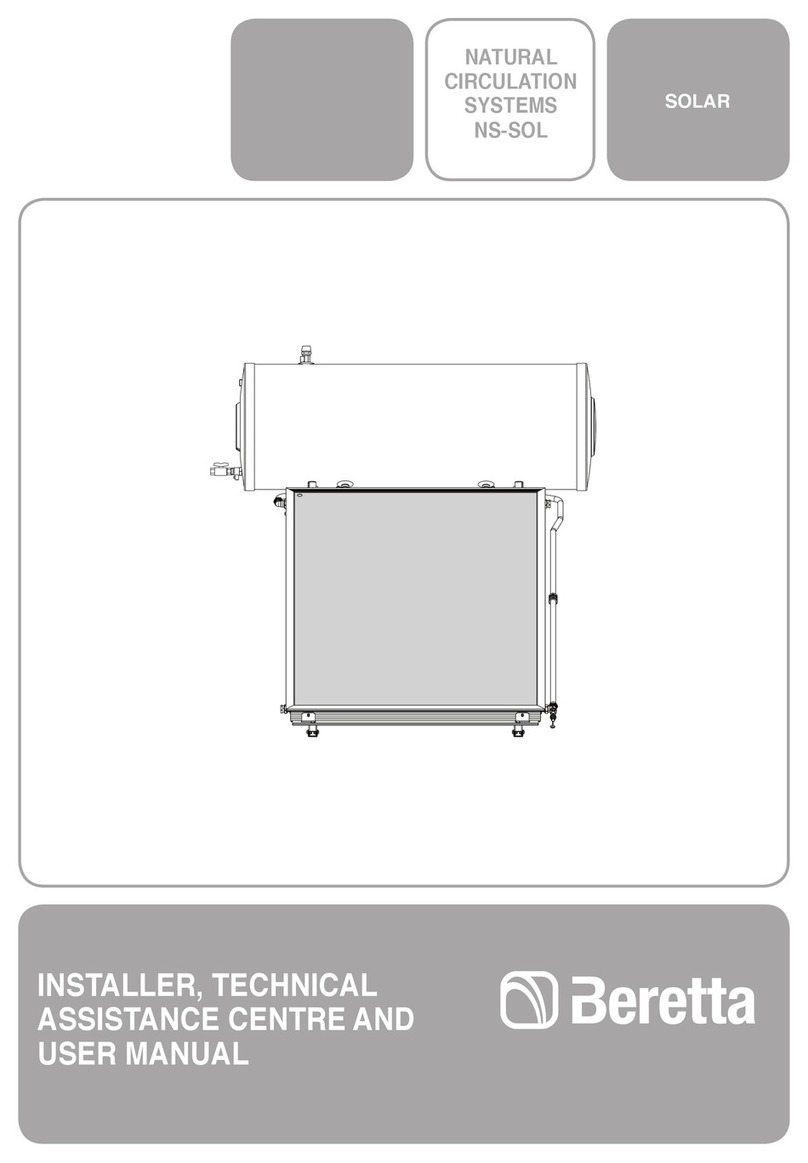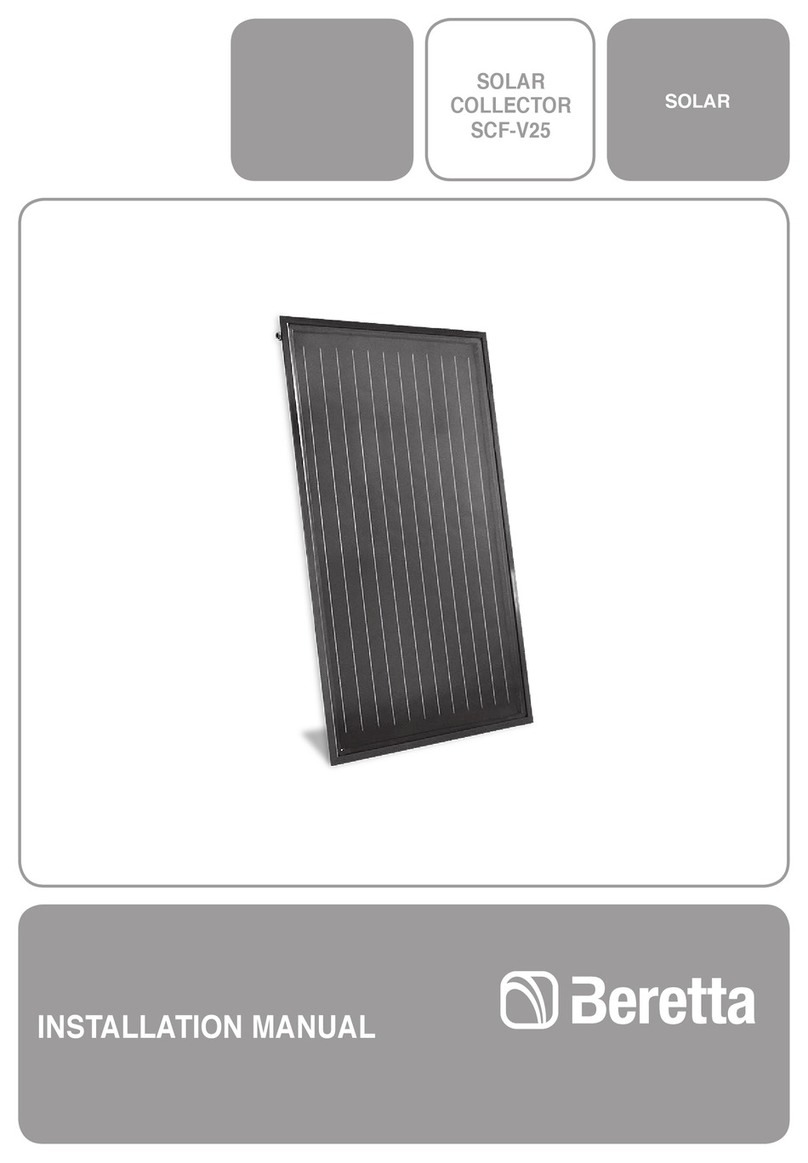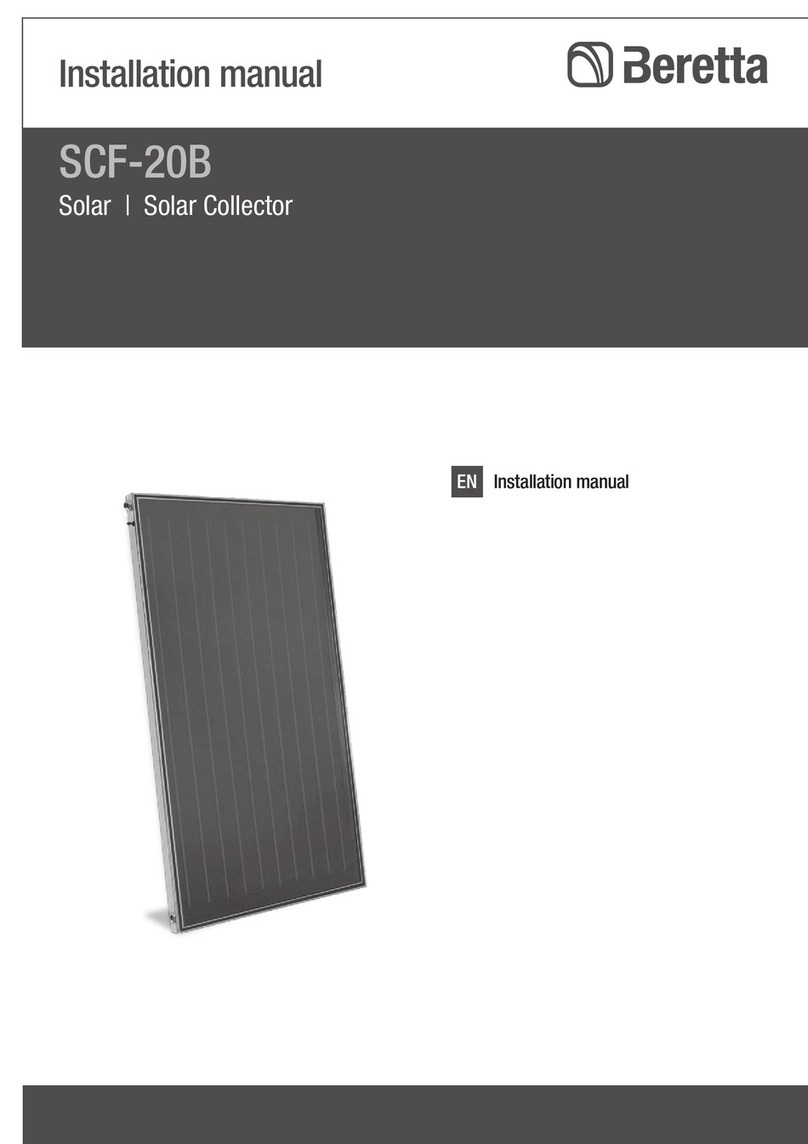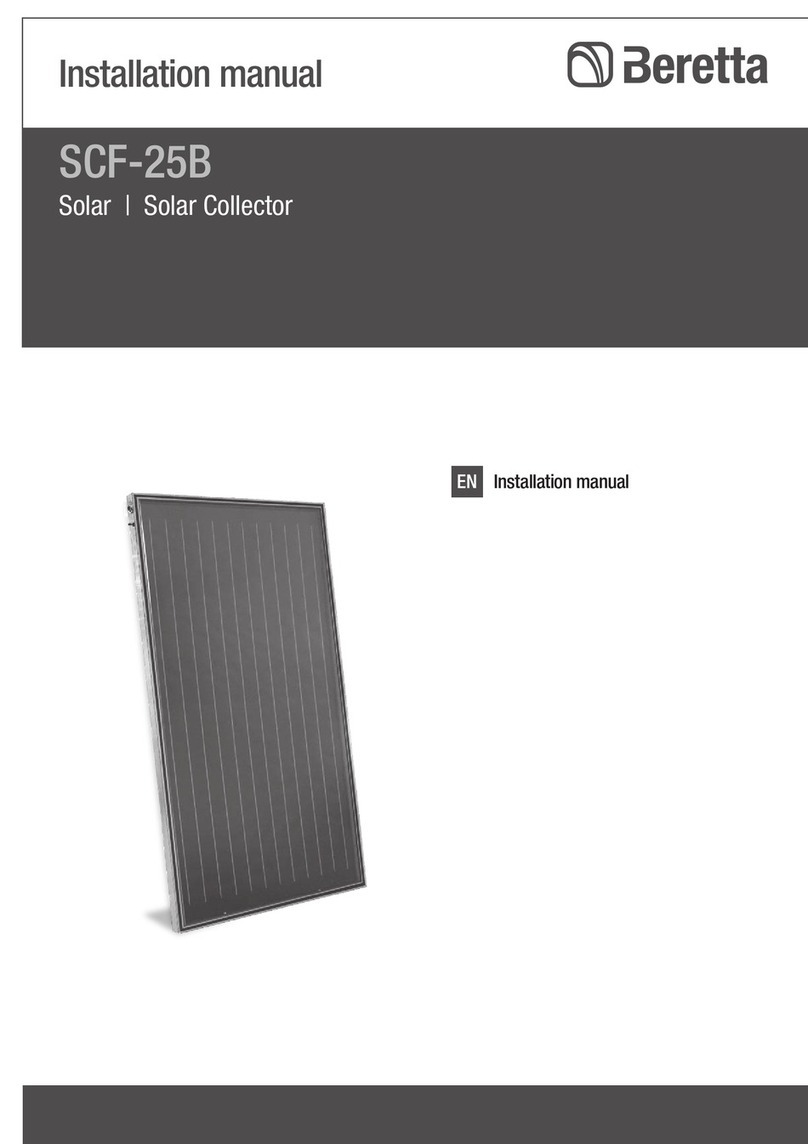Installation
INSTALLATION
GENERAL INSTRUCTIONS
Assembly
The system must be installed by specialist personnel. Use
only the assembly material supplied with the solar collec-
tor. The supporting framework and all masonry or brick-
work fixing points must be checked by a person expert in
static loading, and must be suitable for the nature of the
installation site.
Static load
The solar collector must only be installed on roofs or frames
that are strong enough to support its weight. The strength
of the roof or frame must be verified on site by a person ex-
pert in static loading before the solar collector is installed.
During this process, it is important to verify the suitability
of the supporting frame to hold the screw fasteners that fix
the solar collector in place. An expert in static loading must
verify that the entire frame complies with relevant stand-
ards, especially in areas liable to snow and areas exposed
to high winds. Conditions (gusts of wind, formation of wind
vortices, etc.) at the point where the solar collector is to
be installed must be carefully considered since these can
increase the loads on the supporting structure.
Lightning protection
The metal piping of the solar heating circuit must be con-
nected to the main potential compensation bar by a (yel-
low-green) copper wire (H07 V-U or R) of at least 16 mm2. If
a lightning conductor system is already installed, the solar
collectors may be connected to the existing system. Alter-
natively, the solar collector piping may be connected to
ground via a ground wire sunk into the earth. Ground wires
must be sunk outside the house. The ground wire must be
connected to the potential compensation bar through a
wire of the same diameter.
Water connections
The solar collectors must be connected in series using the
fittings and seal rings provided. If flexible hoses are not
used to connect up the ends of solar collector lines, we
recommend that you fit devices in the connecting pipes
to permit thermal expansion (U-type expansion joints, sec-
tions of flexible hose or dedicated expansion joints). Pro-
vided adequate expansion joints are used, up to 6 solar
collectors may be connected in series. Make sure that the
seal rings are correctly positioned in their seats. When
tightening a fitting with a pipe wrench or spanner, always
hold the opposite fitting steady with a second tool to avoid
damaging the absorber.
b All pipes in the water circuit must be insulated in con-
formity to relevant standards. Lagging and insulation
must be protected against damage by the weather
and birds and animals.
Angle of collectors / General
Solar collectors are designed to be installed at angles of
between 15° (minimum) and 75° (maximum). Make sure
that the bleed and vent valves of the collectors remain
open while the collectors are being installed. Take care
to protect all fittings, connections, bleed and vent valves
against dirt and dust etc. In installations which serve pri-
marily to produce domestic hot water in the summer, install
the collectors facing from east to west at an angle of be-
tween 20 and 60°. The ideal orientation is southwards, at
an angle equal to the latitude of the location minus 10°. If
the system sustains the greatest thermal load in the winter
(as in systems that combine domestic hot water production
with central heating), install the collectors facing south (or
south-east or south-west) at an angle greater than 35°. The
ideal orientation is southwards, at an angle equal to the
latitude of the location plus 10°.
b Work near uncovered and live electrical wires, with
which it is possible to come into contact, is only per-
mitted under the following conditions: wires must be
free from voltage for the entire duration of the work;
parts remaining live must be covered or accidental
contact prevented; the following minimum safety dis-
tances must be respected: 1m (for voltages of up
to 1000 Volts), 3m (for voltages from 1000 to 11000
Volts), 4m (for voltages from 11000 to 22000 Volts),
5m (for voltages from 22000 to 38000 Volts), >5m
(if the voltage is not known). Contact with open, live
electrical wires may lead to electrocution and may
even be fatal.
b Always wear safety goggles when drilling. Always
wear safety shoes, cut-proof protective gloves and a
safety helmet when performing installation work.
b Before beginning installation work on roofs, install the
necessary fall prevention and fall arrest devices and
ensure that all applicable safety standards are ap-
plied. Use only tools and materials that conform to
the safety standards that are applicable in the place
of work.
b Only wear overalls that have a safety harness (with a
suitable safety or fall-arrest belt, ropes or slings, fall
dampers or dissipaters). In the absence of adequate
fall prevention and security devices, failure to use a
proper safety harness may lead to falls from great
heights with serious or even fatal consequences.
b The use of ladders leaned against walls can lead to
serious falls if the ladder slips, slides of falls. When
using ladders, always ensure that they are stable,
and that suitable ladder stops are present. If possible
secure the ladder with hooks. Make sure that there
are no live electrical wires near the ladder.





